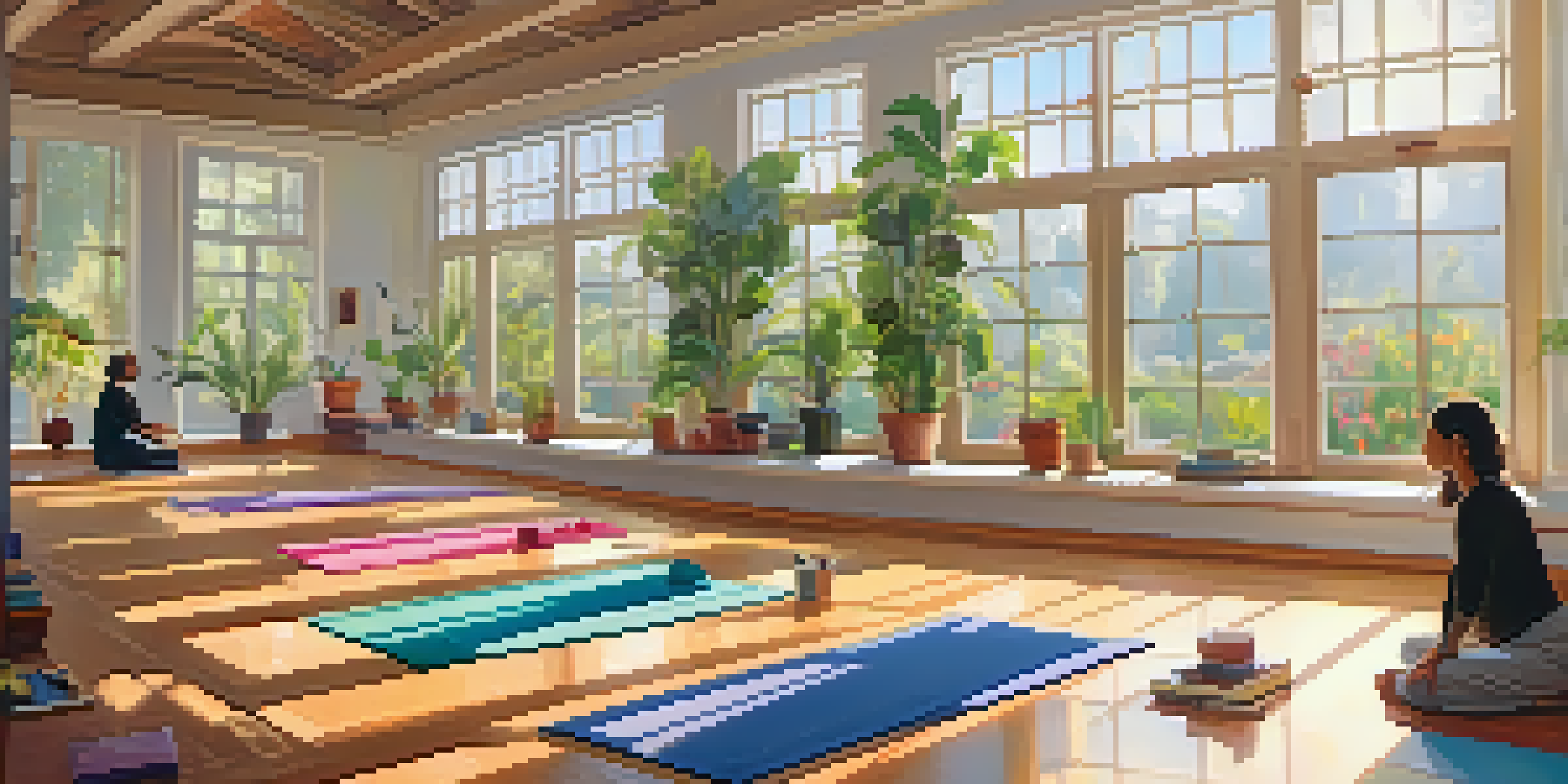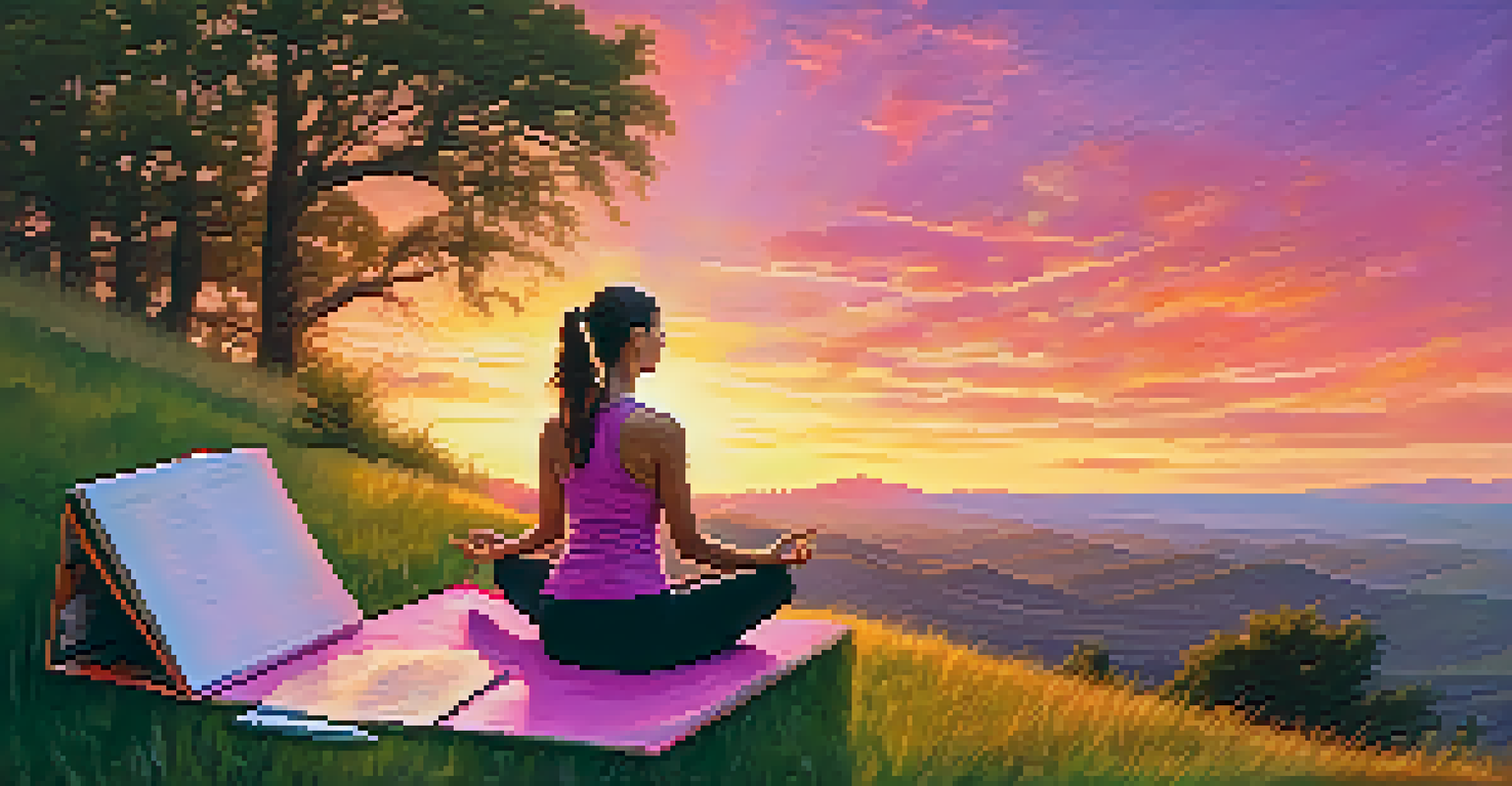Yoga as a Muse: Artists Who Find Inspiration in Yoga Practice

The Connection Between Yoga and Creativity
Yoga is often viewed as a physical practice, but its true essence extends into the realm of creativity. Many artists find that the mindful movements and breath control in yoga open pathways to inspiration. Just as a painter mixes colors on a canvas, yoga allows the mind to blend thoughts and ideas into a harmonious flow.
Yoga is the journey of the self, through the self, to the self.
When in a yoga pose, artists often report a heightened sense of awareness, which can lead to innovative ideas. This state of mindfulness encourages them to observe their surroundings and emotions more deeply. Through this lens, they can transform their feelings into art, making their work more authentic and relatable.
Moreover, yoga teaches patience and resilience—qualities that every artist needs. By embracing the ups and downs of their practice, artists learn to navigate the challenges of their creative journeys with grace. This connection between yoga and creativity is not just anecdotal; many studies suggest that physical movement enhances cognitive function and creative thinking.
Famous Artists Who Practice Yoga
Many renowned artists have openly shared how yoga influences their work. For instance, the celebrated musician Sting credits his yoga practice for bringing clarity and focus to his songwriting. He believes that the discipline of yoga allows him to tap into a deeper reservoir of creativity, leading to more profound lyrics and melodies.

Similarly, acclaimed visual artist Georgia O'Keeffe found inspiration in her yoga practice, which helped her cultivate a strong connection to nature. O'Keeffe often expressed that the calm she experienced during yoga mirrored the tranquility she sought in her paintings. This relationship between her practice and her art allowed her to create iconic pieces that resonate with the beauty of the natural world.
Yoga Boosts Artistic Creativity
Yoga enhances creativity by promoting mindfulness and allowing artists to blend thoughts and emotions into their work.
Even contemporary artists like Pharrell Williams advocate for yoga as a source of inspiration. Pharrell incorporates yoga into his daily routine, finding that it helps him manage stress and explore new creative avenues. His experiences demonstrate that no matter the discipline, yoga can serve as a powerful catalyst for artistic expression.
How Yoga Enhances Focus and Clarity
In the fast-paced world of art, maintaining focus can be a challenge. Yoga provides artists with the tools to cultivate concentration and mental clarity. Through meditation and breathwork, practitioners learn to quiet their minds, allowing them to hone in on their creative tasks without distraction.
Creativity is intelligence having fun.
This ability to focus is crucial, especially when artists are working on complex pieces that require deep thought and attention to detail. By practicing yoga, they can develop a heightened sense of presence, which translates into their art. Whether it’s a delicate brushstroke or a nuanced musical note, this clarity can make all the difference.
Additionally, yoga encourages artists to embrace a mindset of flow. This state, where they lose track of time and are fully absorbed in their work, is often described as 'being in the zone.' By fostering this flow state, yoga helps artists unlock their full creative potential, resulting in more impactful and inspired creations.
The Role of Breath in Creative Expression
Breath is a fundamental component of yoga, and its significance extends into the realm of creativity. Many artists find that conscious breathing can help them manage anxiety and channel energy into their work. This intentional focus on breath allows them to stay grounded, even during intense creative sessions.
For instance, a sculptor might take a moment to breathe deeply before starting a new piece, centering their thoughts and emotions. This practice not only calms the mind but also fuels the creative spirit, making the process more enjoyable and fulfilling. Breathing techniques can also serve as a warm-up, similar to how musicians might tune their instruments before a performance.
Famous Artists Embrace Yoga
Many renowned artists, like Sting and Georgia O'Keeffe, attribute their creative clarity and inspiration to their yoga practices.
Furthermore, breath control can enhance physical performance in artistic disciplines. Dancers, for example, use breath to synchronize their movements and express emotions more powerfully. In this way, the practice of yoga reinforces the connection between body, mind, and art, allowing for a more profound expression of creativity.
Finding Balance: Art and Life Through Yoga
The balance between artistic pursuits and personal life can often feel precarious. Yoga teaches artists how to find equilibrium, enabling them to navigate the pressures of their careers while maintaining their well-being. This holistic approach encourages them to prioritize self-care, which ultimately enhances their creativity.
For many, yoga becomes a sanctuary where they can reflect on their artistic journey. It offers a moment to step back, reassess goals, and reconnect with the reasons they create. This mindful practice allows artists to recharge their spirits, leading to renewed inspiration and motivation.
Additionally, the principles of yoga—such as acceptance and non-attachment—can influence how artists approach their work. By embracing imperfections and allowing their art to evolve naturally, they create a more authentic expression. This balance between artistry and life's demands ultimately fosters a healthier, more sustainable creative practice.
The Community Aspect of Yoga and Art
Yoga is not just a solitary practice; it often fosters a sense of community that can be incredibly beneficial for artists. Group classes and workshops provide opportunities for collaboration and support, which can lead to new creative ideas. When artists come together, they share experiences and insights that can spark inspiration.
This sense of community can also alleviate the isolation that many artists face. In sharing their struggles and triumphs, they can find encouragement and motivation from peers. The collaborative spirit that emerges in yoga spaces often extends to artistic endeavors, leading to exciting projects and partnerships.
Yoga Cultivates Focus and Balance
Through yoga, artists develop focus and balance, helping them manage stress and navigate the complexities of their creative journeys.
Moreover, many art events and retreats incorporate yoga into their programs, recognizing the synergy between the two practices. These gatherings allow artists to explore their creativity in a nurturing environment, surrounded by like-minded individuals. The blending of yoga and art creates a dynamic atmosphere that fuels inspiration and fosters lasting connections.
Creating Rituals: Yoga as Part of the Artistic Process
Incorporating yoga into the daily routine can transform an artist's creative process. Many artists establish rituals that include yoga practice, allowing them to set intentions before diving into their work. These rituals can serve as a grounding mechanism, helping them approach their craft with clarity and purpose.
For example, a writer might start their day with a short yoga session to clear their mind and cultivate inspiration. This practice helps them transition from the hustle of daily life to the focused mindset needed for writing. Establishing such rituals can create a sense of structure and stability in the often unpredictable world of art.

Additionally, these rituals can mark the end of a creative session, providing closure and reflection. By taking a moment to practice yoga after a long day of work, artists can release any tension and celebrate their accomplishments. This cycle of creation and reflection not only enhances their art but also nurtures their overall well-being.